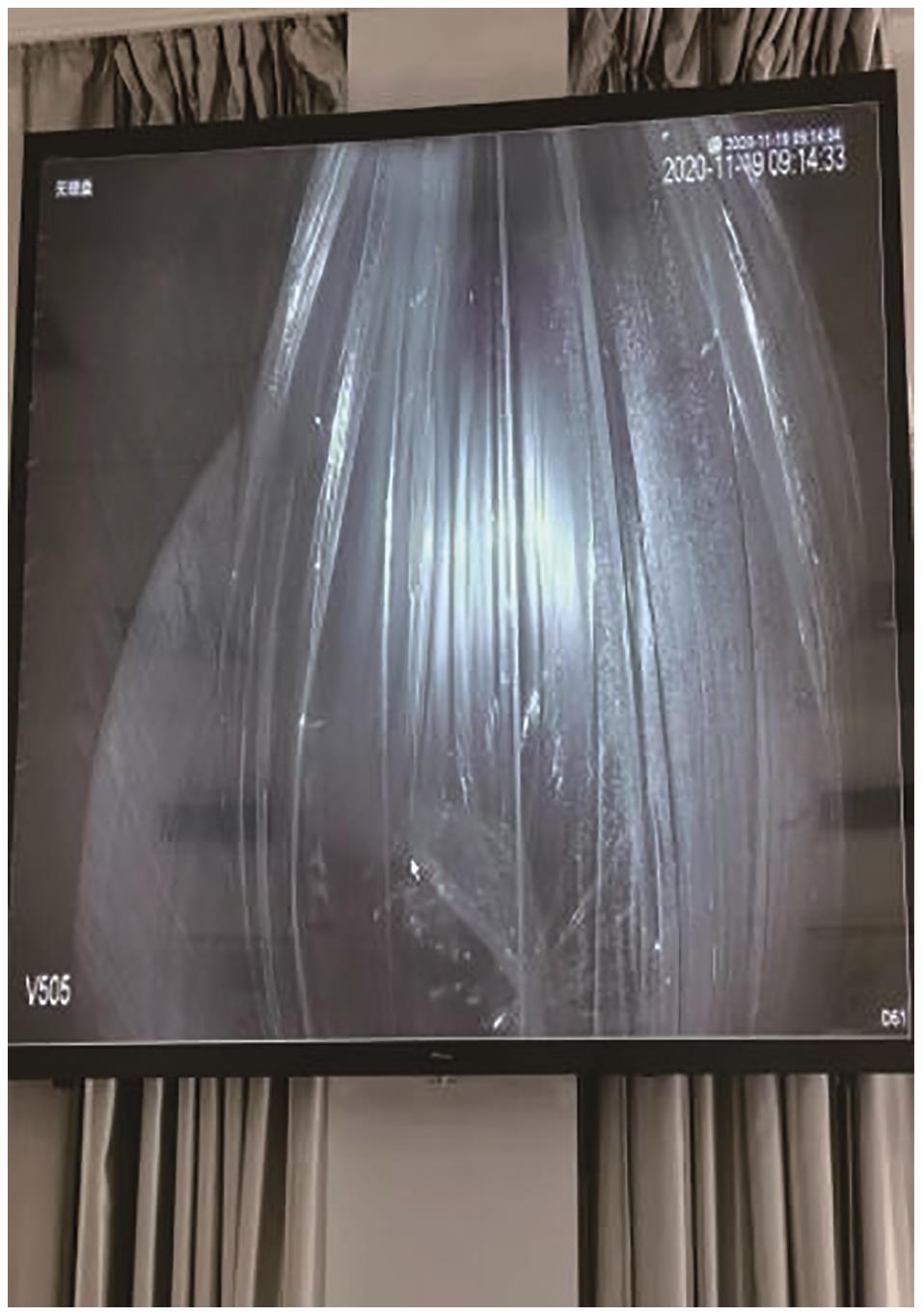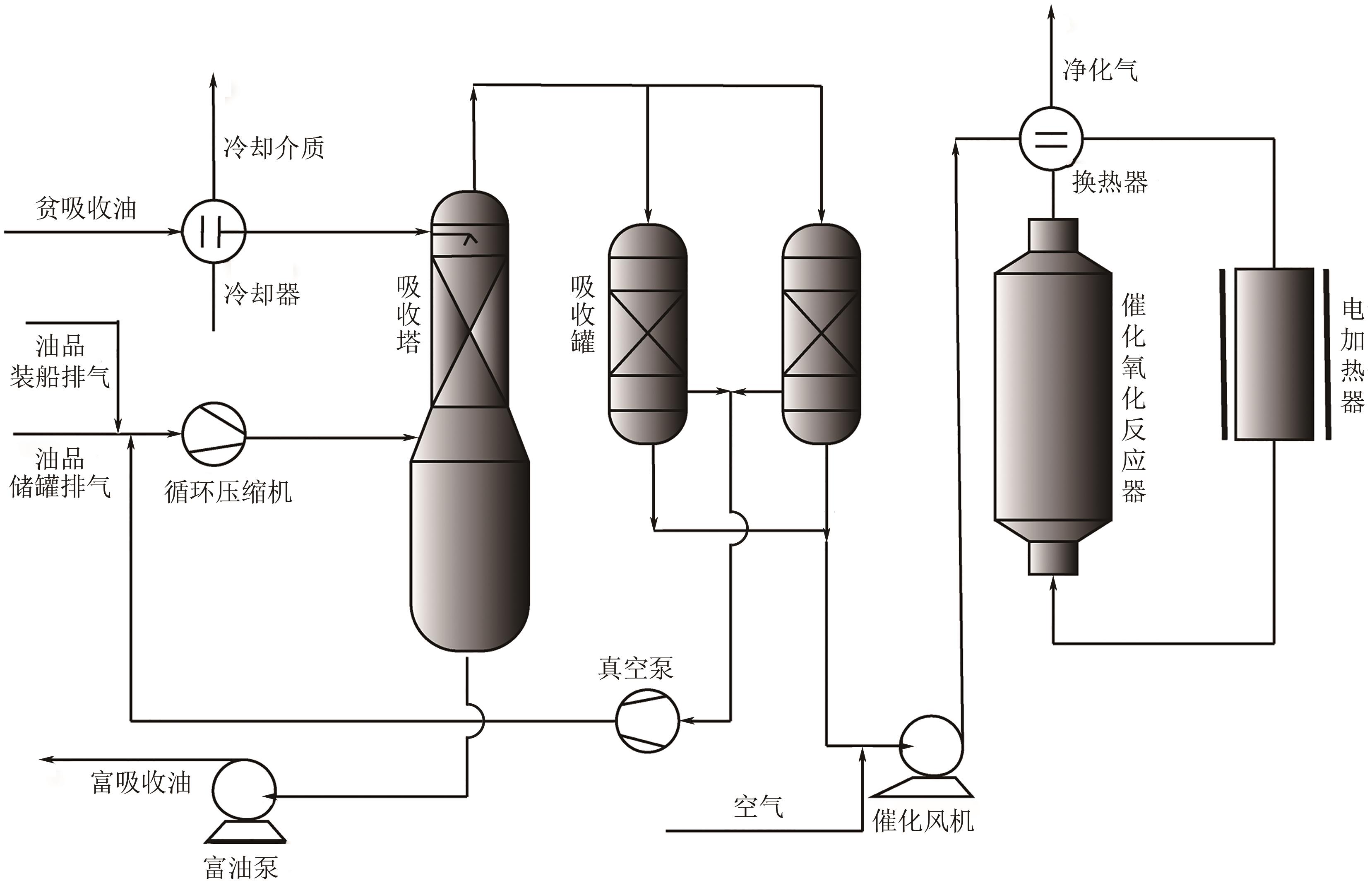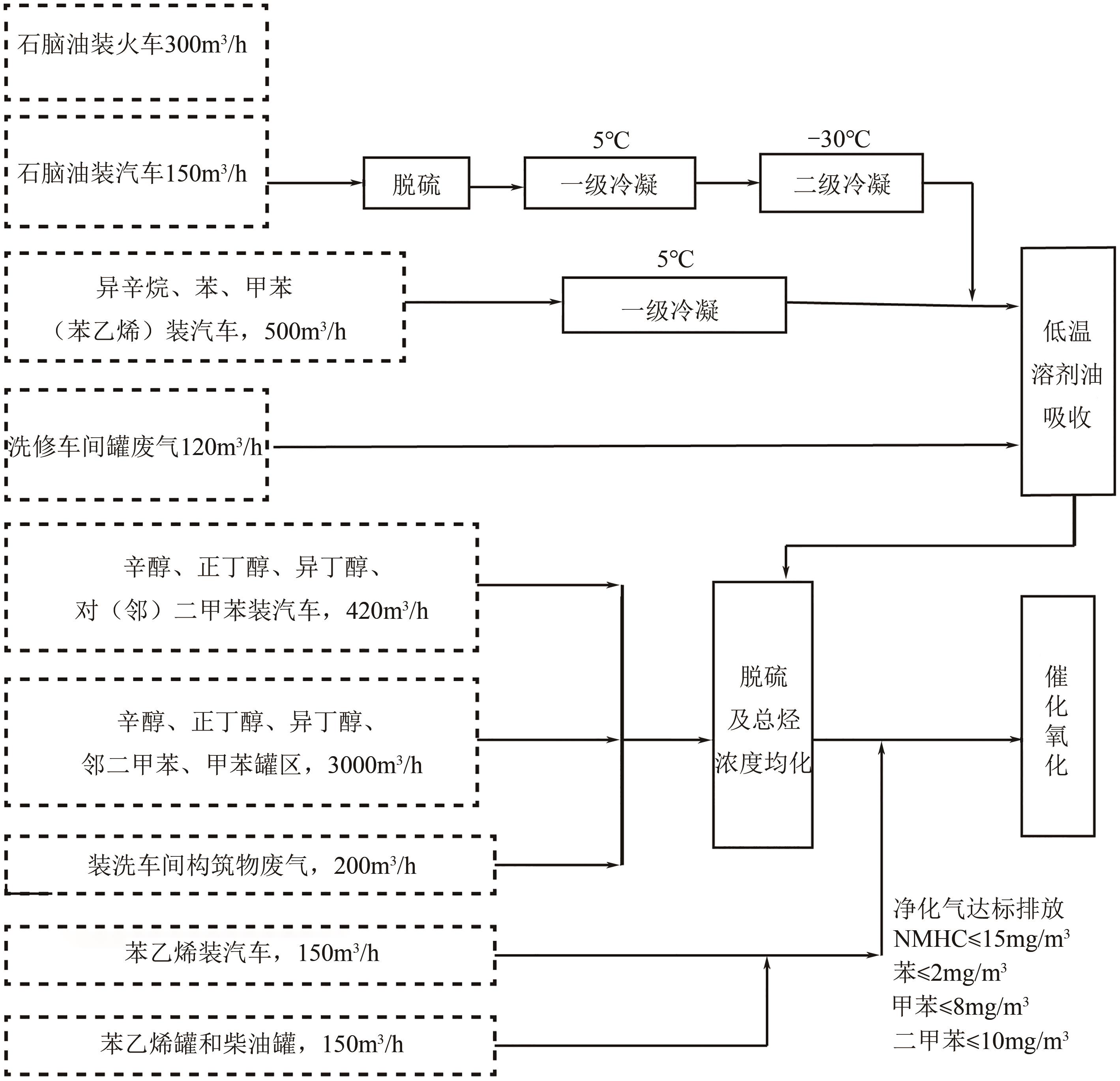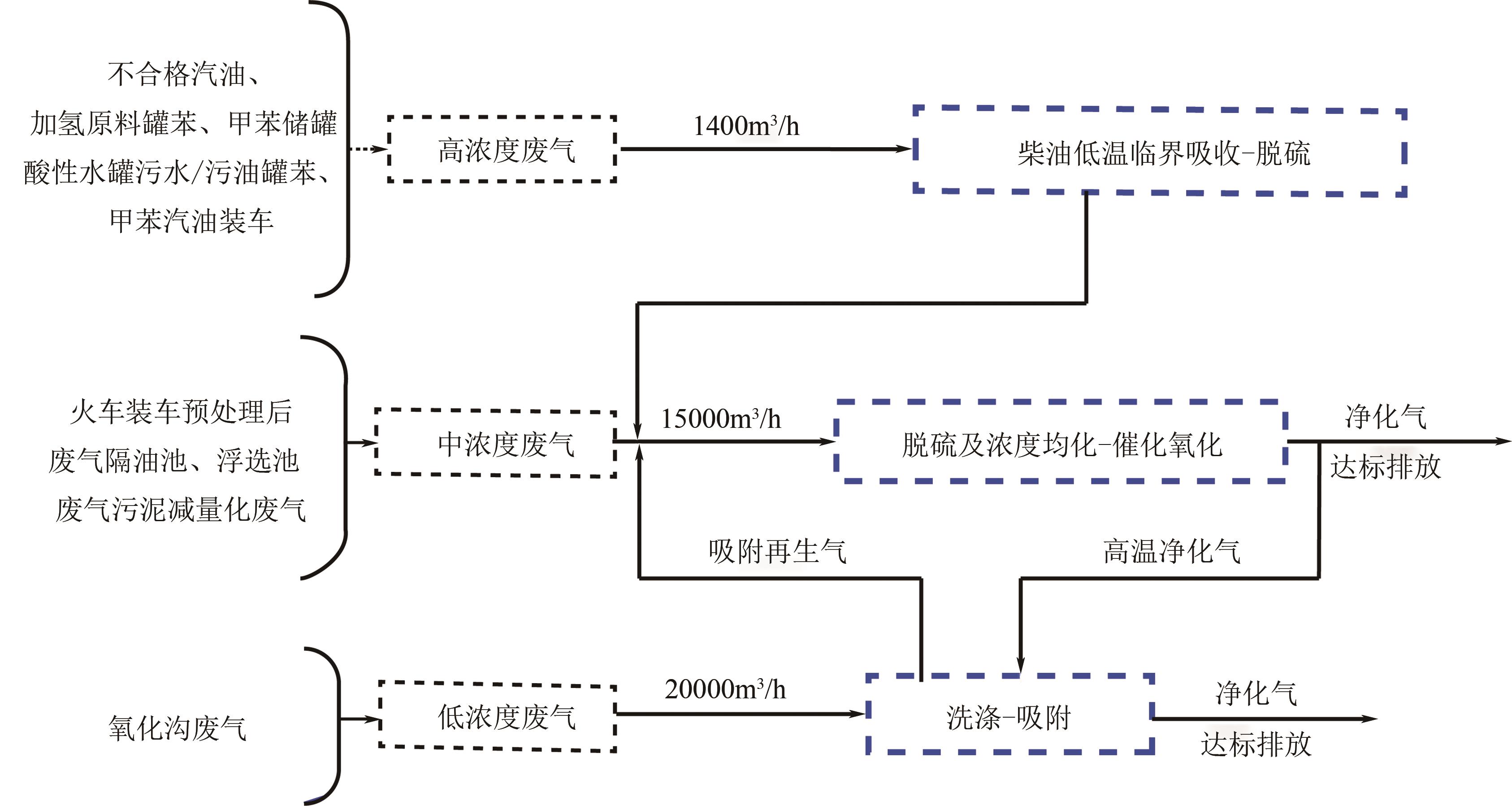Chemical Industry and Engineering Progress ›› 2024, Vol. 43 ›› Issue (4): 2063-2076.DOI: 10.16085/j.issn.1000-6613.2023-0623
• Resources and environmental engineering • Previous Articles
Recent advances in safely efficient deep emission reduction, recovery and thermal oxidation of VOCs from petrochemical storage tanks in China
LIU Shida1( ), WANG Haiyan2, HOU Shuandi1, LIU Zhongsheng1, LIAO Changjian1, WANG Kuanling1
), WANG Haiyan2, HOU Shuandi1, LIU Zhongsheng1, LIAO Changjian1, WANG Kuanling1
- 1.Sinopec (Dalian) Petrochemical Research Institute Co. , Ltd. , Dalian 116045, Liaoning, China
2.School of Chemical Engineering, Ocean and Life Science, Dalian University of Technology, Dalian 116081, Liaoning, China
-
Received:2023-04-18Revised:2023-08-01Online:2024-05-13Published:2024-04-15 -
Contact:LIU Shida
我国石化储罐VOCs安全高效深度减排、回收和热氧化技术进展
刘世达1( ), 王海燕2, 侯栓弟1, 刘忠生1, 廖昌建1, 王宽岭1
), 王海燕2, 侯栓弟1, 刘忠生1, 廖昌建1, 王宽岭1
- 1.中石化(大连)石油化工研究院有限公司,辽宁 大连 116045
2.大连理工大学化工海洋与生命学院,辽宁 大连 116081
-
通讯作者:刘世达 -
作者简介:刘世达(1987—),男,博士,副研究员,研究方向为石化废气治理。E-mail:liushida.fshy@sinopec.com。 -
基金资助:生态环境部国家大气污染防治功关联合中心项目(DQGG202019);中国石化科技部项目(322075)
CLC Number:
Cite this article
LIU Shida, WANG Haiyan, HOU Shuandi, LIU Zhongsheng, LIAO Changjian, WANG Kuanling. Recent advances in safely efficient deep emission reduction, recovery and thermal oxidation of VOCs from petrochemical storage tanks in China[J]. Chemical Industry and Engineering Progress, 2024, 43(4): 2063-2076.
刘世达, 王海燕, 侯栓弟, 刘忠生, 廖昌建, 王宽岭. 我国石化储罐VOCs安全高效深度减排、回收和热氧化技术进展[J]. 化工进展, 2024, 43(4): 2063-2076.
share this article
Add to citation manager EndNote|Ris|BibTeX
URL: https://hgjz.cip.com.cn/EN/10.16085/j.issn.1000-6613.2023-0623
| 罐型 | 相对排放系数 |
|---|---|
| 固定顶罐 | 1 |
| 外浮顶罐 | 0.1~0.15 |
| 内浮顶罐 | 0.05~0.1 |
| 低压罐+排气处理 | <0.01 |
| 压力罐 | 约为0 |
| 罐型 | 相对排放系数 |
|---|---|
| 固定顶罐 | 1 |
| 外浮顶罐 | 0.1~0.15 |
| 内浮顶罐 | 0.05~0.1 |
| 低压罐+排气处理 | <0.01 |
| 压力罐 | 约为0 |
| 类型 | 序号 | 标准/政令 |
|---|---|---|
| 美国主要标准 | 1 | 40 CFR-60-K①:1973年6月11日后至1978年5月19日前新建、重建或改造的石油液体储罐的性能标准 |
| 2 | 40 CFR-60-Ka:1978年5月18日后至1984年7月23日前新建、重建或改造的石油液体储罐的性能标准 | |
| 3 | 40 CFR-60-Kb:1984年7月23日后新建、重建或改造的挥发性有机液体储罐(包括石油液体储罐)的性能标准 | |
| 4 | 40 CFR-61-Y②:苯储存容器的苯排放国家标准 | |
| 5 | 40 CFR-63-CC③:石油炼制工业有害空气污染物(HAPs)排放国家标准 | |
| 6 | 40 CFR-63-F:合成有机化学品制造业HAPs排放国家标准 | |
| 7 | 40 CFR-63-G:合成有机化学品制造工艺排气口、储罐、输送作业和废水的有机HAPs排放国家标准 | |
| 8 | 40 CFR-65-C④:储存容器 | |
| 9 | OSHA No.1910.95⑤:职业健康和环境控制标准 | |
| 中国标准 | 1 | GB 31570—2015《石油炼制工业污染物排放标准》 |
| 2 | GB 31571—2015《石油化学工业污染物排放标准》 | |
| 3 | GB 31572—2015《合成树脂工业污染物排放标准》 | |
| 4 | GB 37822—2019《挥发性有机物无组织排放控制标准》 | |
| 5 | GB 37823—2019《制药工业大气污染物排放标准》 | |
| 6 | GB 39728—2020《陆上石油天然气开采工业大气污染物排放标准》 | |
| 7 | GB 20950—2020《储油库大气污染物排放标准》 | |
| 8 | GB 14554—1993《恶臭污染物排放标准》 | |
| 9 | GBZ 2.1—2019《工作场所有害因素职业接触限值第1部分:化学有害因素》 | |
| 10 | HJ 1094—2020《石油炼制工业废气治理工程技术规范》 | |
| 11 | 北京市DB11/447—2015《炼油与石油化学工业大气污染物排放标准》 | |
| 12 | 北京市DB11/1385—2017《有机化学品制造业大气污染物排放标准》 | |
| 13 | 天津市DB12/524—2020《工业企业挥发性有机物排放控制标准》 | |
| 14 | 河北省 DB13/2322—2016《工业企业挥发性有机物排放控制标准》 | |
| 15 | 山东省 DB37/2801.6—2018《挥发性有机物排放标准第6部分:有机化工行业》 | |
| 中国政府和 企业政令 | 1 | 环境保护部《石化行业挥发性有机物综合整治方案》(环发〔2014〕177号) |
| 2 | 生态环境部《重点行业挥发性有机物综合治理方案》(环大气〔2019〕53号) | |
| 3 | 生态环境部《2020年挥发性有机物治理攻坚方案》(环大气〔2020〕33号) | |
| 4 | 生态环境部《重污染天气重点行业应急减排措施制定技术指南(2020年修订版)》(环办大气函〔2020〕340号) | |
| 5 | 生态环境部《关于加快解决当前挥发性有机物治理突出问题的通知》(环大气〔2021〕65号) | |
| 6 | 生态环境部《2021—2022年秋冬季大气污染综合治理攻坚方案》(环大气〔2021〕104号) | |
| 7 | 中国石化2020年总经理1号令《臭氧污染防治专项行动方案》 | |
| 8 | 中国石化能环部关于印发《内浮顶储罐VOCs治理环保技术要求(试行)》的通知(2021.9.9) |
| 类型 | 序号 | 标准/政令 |
|---|---|---|
| 美国主要标准 | 1 | 40 CFR-60-K①:1973年6月11日后至1978年5月19日前新建、重建或改造的石油液体储罐的性能标准 |
| 2 | 40 CFR-60-Ka:1978年5月18日后至1984年7月23日前新建、重建或改造的石油液体储罐的性能标准 | |
| 3 | 40 CFR-60-Kb:1984年7月23日后新建、重建或改造的挥发性有机液体储罐(包括石油液体储罐)的性能标准 | |
| 4 | 40 CFR-61-Y②:苯储存容器的苯排放国家标准 | |
| 5 | 40 CFR-63-CC③:石油炼制工业有害空气污染物(HAPs)排放国家标准 | |
| 6 | 40 CFR-63-F:合成有机化学品制造业HAPs排放国家标准 | |
| 7 | 40 CFR-63-G:合成有机化学品制造工艺排气口、储罐、输送作业和废水的有机HAPs排放国家标准 | |
| 8 | 40 CFR-65-C④:储存容器 | |
| 9 | OSHA No.1910.95⑤:职业健康和环境控制标准 | |
| 中国标准 | 1 | GB 31570—2015《石油炼制工业污染物排放标准》 |
| 2 | GB 31571—2015《石油化学工业污染物排放标准》 | |
| 3 | GB 31572—2015《合成树脂工业污染物排放标准》 | |
| 4 | GB 37822—2019《挥发性有机物无组织排放控制标准》 | |
| 5 | GB 37823—2019《制药工业大气污染物排放标准》 | |
| 6 | GB 39728—2020《陆上石油天然气开采工业大气污染物排放标准》 | |
| 7 | GB 20950—2020《储油库大气污染物排放标准》 | |
| 8 | GB 14554—1993《恶臭污染物排放标准》 | |
| 9 | GBZ 2.1—2019《工作场所有害因素职业接触限值第1部分:化学有害因素》 | |
| 10 | HJ 1094—2020《石油炼制工业废气治理工程技术规范》 | |
| 11 | 北京市DB11/447—2015《炼油与石油化学工业大气污染物排放标准》 | |
| 12 | 北京市DB11/1385—2017《有机化学品制造业大气污染物排放标准》 | |
| 13 | 天津市DB12/524—2020《工业企业挥发性有机物排放控制标准》 | |
| 14 | 河北省 DB13/2322—2016《工业企业挥发性有机物排放控制标准》 | |
| 15 | 山东省 DB37/2801.6—2018《挥发性有机物排放标准第6部分:有机化工行业》 | |
| 中国政府和 企业政令 | 1 | 环境保护部《石化行业挥发性有机物综合整治方案》(环发〔2014〕177号) |
| 2 | 生态环境部《重点行业挥发性有机物综合治理方案》(环大气〔2019〕53号) | |
| 3 | 生态环境部《2020年挥发性有机物治理攻坚方案》(环大气〔2020〕33号) | |
| 4 | 生态环境部《重污染天气重点行业应急减排措施制定技术指南(2020年修订版)》(环办大气函〔2020〕340号) | |
| 5 | 生态环境部《关于加快解决当前挥发性有机物治理突出问题的通知》(环大气〔2021〕65号) | |
| 6 | 生态环境部《2021—2022年秋冬季大气污染综合治理攻坚方案》(环大气〔2021〕104号) | |
| 7 | 中国石化2020年总经理1号令《臭氧污染防治专项行动方案》 | |
| 8 | 中国石化能环部关于印发《内浮顶储罐VOCs治理环保技术要求(试行)》的通知(2021.9.9) |
| 排序 | 储存油品/温度/蒸气压 | 储罐类型 | 液体储存量/104t·a-1 | VOCs排放量/t·a-1 |
|---|---|---|---|---|
| 合计 | 389317.3(901269.4) | |||
| 1 | 粗柴油/22(40)℃/3.7(8.14)kPa① | 固定顶 | 16638.3 | 84798.2(172440) |
| 2 | 柴油/22(40)℃/3.7(8.14)kPa | 固定顶 | 14618.4 | 74530.6(151505) |
| 3 | 原油/22(45)℃/30.8(62)kPa | 外浮顶 | 69592 | 71416(75351.7) |
| 4 | 汽油/22℃/52kPa | 内浮顶(双封) | 13162 | 40256 |
| 5 | 粗汽油/22(38)℃/44(91.8)kPa | 内浮顶(双封) | 14120.7 | 32986(117342) |
| 6 | 粗航煤/22(40)℃/3.7(8.1)kPa | 固定顶 | 5252 | 26858.2(54522.9) |
| 7 | 航煤/22(40)℃/3.7(8.14)kPa | 固定顶 | 3869.6 | 19788.7(40171.7) |
| 8 | 蜡油/120℃/0.25kPa | 固定顶 | 20877.6 | 11151.4 |
| 9 | 燃料油/90℃/2.38kPa | 固定顶 | 2838 | 7792.4 |
| 10 | 渣油/120℃/0.18kPa | 固定顶 | 13918.4 | 6044.5 |
| 11 | 乙醇/22℃/8.0kPa | 固定顶 | 986.45 | 3935.5 |
| 12 | 正、异丙醇/20℃/4.4kPa | 内浮顶(双封) | 57.2 | 3105.2 |
| 13 | 乙苯/25.9℃/1.33kPa | 固定顶 | 954.23 | 1659.5 |
| 14 | 醋酸/22℃/2.06kPa | 固定顶 | 743.93 | 1330.4 |
| 15 | 石脑油/22(36.9)℃/63.1(102)kPa | 内浮顶(双封) | 4598.52 | 1264.7(212321.2) |
| 16 | 异丙苯/25.9℃/2.48kPa | 固定顶 | 150 | 667.7 |
| 17 | 甲醇/22℃/12.3kPa | 内浮顶(双封) | 7288 | 602.7 |
| 18 | 环己酮/38.5℃/1.33kPa | 固定顶 | 338 | 564.2 |
| 19 | 丙烯酸/40℃/1.33kPa | 固定顶 | 250 | 340 |
| 20 | 对二甲苯/22℃/0.98kPa | 内浮顶(双封) | 2957.6 | 225.4 |
| 排序 | 储存油品/温度/蒸气压 | 储罐类型 | 液体储存量/104t·a-1 | VOCs排放量/t·a-1 |
|---|---|---|---|---|
| 合计 | 389317.3(901269.4) | |||
| 1 | 粗柴油/22(40)℃/3.7(8.14)kPa① | 固定顶 | 16638.3 | 84798.2(172440) |
| 2 | 柴油/22(40)℃/3.7(8.14)kPa | 固定顶 | 14618.4 | 74530.6(151505) |
| 3 | 原油/22(45)℃/30.8(62)kPa | 外浮顶 | 69592 | 71416(75351.7) |
| 4 | 汽油/22℃/52kPa | 内浮顶(双封) | 13162 | 40256 |
| 5 | 粗汽油/22(38)℃/44(91.8)kPa | 内浮顶(双封) | 14120.7 | 32986(117342) |
| 6 | 粗航煤/22(40)℃/3.7(8.1)kPa | 固定顶 | 5252 | 26858.2(54522.9) |
| 7 | 航煤/22(40)℃/3.7(8.14)kPa | 固定顶 | 3869.6 | 19788.7(40171.7) |
| 8 | 蜡油/120℃/0.25kPa | 固定顶 | 20877.6 | 11151.4 |
| 9 | 燃料油/90℃/2.38kPa | 固定顶 | 2838 | 7792.4 |
| 10 | 渣油/120℃/0.18kPa | 固定顶 | 13918.4 | 6044.5 |
| 11 | 乙醇/22℃/8.0kPa | 固定顶 | 986.45 | 3935.5 |
| 12 | 正、异丙醇/20℃/4.4kPa | 内浮顶(双封) | 57.2 | 3105.2 |
| 13 | 乙苯/25.9℃/1.33kPa | 固定顶 | 954.23 | 1659.5 |
| 14 | 醋酸/22℃/2.06kPa | 固定顶 | 743.93 | 1330.4 |
| 15 | 石脑油/22(36.9)℃/63.1(102)kPa | 内浮顶(双封) | 4598.52 | 1264.7(212321.2) |
| 16 | 异丙苯/25.9℃/2.48kPa | 固定顶 | 150 | 667.7 |
| 17 | 甲醇/22℃/12.3kPa | 内浮顶(双封) | 7288 | 602.7 |
| 18 | 环己酮/38.5℃/1.33kPa | 固定顶 | 338 | 564.2 |
| 19 | 丙烯酸/40℃/1.33kPa | 固定顶 | 250 | 340 |
| 20 | 对二甲苯/22℃/0.98kPa | 内浮顶(双封) | 2957.6 | 225.4 |
| 1 | VIRDI S S, LEE L Y, LI C, et al. Simulation of VOC emission during loading operations in a crude oil tanker[J]. International Journal of Maritime Engineering, 2021, 163(A1): 1-16. |
| 2 | SIMAYI Maimaiti, HAO Yufang, LI Jing, et al. Historical volatile organic compounds emission performance and reduction potentials in China’s petroleum refining industry[J]. Journal of Cleaner Production, 2021, 292: 125810. |
| 3 | YU Daqi, LU Sihua, TAN Xin, et al. Source profiles, emission factors and associated contributions to secondary pollution of volatile organic compounds (VOCs) emitted from a local petroleum refinery in Shandong[J]. Environmental Pollution, 2021, 274: 116589. |
| 4 | 王凤林. 炼油厂油品储运技术及管理[M]. 北京: 中国石化出版社, 2010: 271-273. |
| WANG Fenglin. Oil storage and transportation technology and management in refinery[M]. Beijing: China Petrochemical Press, 2010: 271-273. | |
| 5 | 刘忠生, 郭兵兵, 齐慧敏. 炼油厂酸性水罐区排放气量分析计算[J]. 当代化工, 2009, 38(3): 248-251, 268. |
| LIU Zhongsheng, GUO Bingbing, QI Huimin. Analysis and calculation of flow rate of vent gas from sour water tanks in refinery[J]. Contemporary Chemical Industry, 2009, 38(3): 248-251, 268. | |
| 6 | 中华人民共和国生态环境部. 石油炼制工业废气治理工程技术规范: [S]. 北京: 中国环境科学出版社, 2020. |
| Ministry of Ecology and Environment of the People’s Republic of China. Technical specifications for petroleum refining industry waste gases treatment: [S]. Beijing: China Environmental Science Press, 2020. | |
| 7 | 刘忠生, 廖昌建, 陈玉香. 炼油厂恶臭和VOCs无组织排放量计算方法[J]. 炼油技术与工程, 2014, 44(6): 61-64. |
| LIU Zhongsheng, LIAO Changjian, CHEN Yuxiang. Calculation method for fugitive emissions of odor and VOCs in refinery[J]. Petroleum Refinery Engineering, 2014, 44(6): 61-64. | |
| 8 | 李飞, 黄维秋, 纪虹, 等. 浮盘和气窗位置对内浮顶罐正己烷蒸发损耗的影响[J]. 环境工程学报, 2018, 12(2): 410-416. |
| LI Fei, HUANG Weiqiu, JI Hong, et al. Influence of floating roof and vent locations on n-hexane evaporative losses of internal floating-roof tanks[J]. Chinese Journal of Environmental Engineering, 2018, 12(2): 410-416. | |
| 9 | 李凌波, 郭兵兵, 刘忠生. 炼油厂恶臭污染源综合监测与评价Ⅱ.污染源分级与排放评估[J]. 石油炼制与化工, 2013, 44(2): 77-83. |
| LI Lingbo, GUO Bingbing, LIU Zhongsheng. Comprehensive monitoring and assessment of odour emission sources from refineryⅡ.Classification of odorous sources and emission assessment[J]. Petroleum Processing and Petrochemicals, 2013, 44(2): 77-83. | |
| 10 | 曹冬冬, 李兴春, 薛明. 石化中间储罐挥发性有机物排放特征与反应活性[J]. 化工进展, 2022, 41(7): 3974-3982. |
| CAO Dongdong, LI Xingchun, XUE Ming. Emission characteristics and photochemical reactivity of volatile organic compounds from petrochemical intermediate storage tanks[J]. Chemical Industry and Engineering Progress, 2022, 41(7): 3974-3982. | |
| 11 | 冯成红. 内浮顶罐和低压罐储存石脑油的经济性比较[J]. 石油化工设备技术, 2015, 36(5): 3, 6-8. |
| FENG Chenghong. Economic comparison between storage tanks with internal floating roof and low-pressure tanks for naphtha storage[J]. Petro-Chemical Equipment Technology, 2015, 36(5): 3, 6-8. | |
| 12 | Standards of performance for new stationary sources: 40 CFR-60 [S]. Washington: Environmental Protection Agency, 1971. |
| 13 | National emission standards for hazardous air pollutants: 40 CFR-61 [S]. Washington: Environmental Protection Agency, 1973. |
| 14 | National emission standards for hazardous air pollutants for source categories: 40 CFR-63 [S]. Washington: Environmental Protection Agency, 1992. |
| 15 | Consolidated federal air rule: 40 CFR-65 [S]. Washington: Environmental Protection Agency, 2000. |
| 16 | Occupational safety and health standards: Occupational health and environmental control: 1910.95 [S]. Washington: Occupational Safety and Health Administration, 1970. |
| 17 | 王亘, 王宗爽, 王元刚, 等. 国内外恶臭污染控制标准研究[J]. 环境科学与技术, 2012, 35(S2): 147-151. |
| WANG Gen, WANG Zongshuang, WANG Yuangang, et al. Study on odor pollution control standard at home and abroad[J]. Environmental Science & Technology, 2012, 35(S2): 147-151. | |
| 18 | 朱中杨, 颜玉玺, 金博强, 等. 国内外恶臭污染排放法规的进展[J]. 应用化工, 2021, 50(8): 2194-2199. |
| ZHU Zhongyang, YAN Yuxi, JIN Boqiang, et al. State-of-the-art outlook for domestic and foreign odor pollution regulations[J]. Applied Chemical Industry, 2021, 50(8): 2194-2199. | |
| 19 | 刘忠生, 王海波, 王新, 等. 汽油、喷气燃料、苯乙烯、甲醇等装车(船)挥发性有机物废气深度净化技术[J]. 石油炼制与化工, 2018, 49(7): 73-80. |
| LIU Zhongsheng, WANG Haibo, WANG Xin, et al. Deep purification technologies for VOCs waste gases during loading of gasoline, jet fuel, styrene and methanol[J]. Petroleum Processing and Petrochemicals, 2018, 49(7): 73-80. | |
| 20 | 刘世达, 侯栓弟, 刘忠生, 等. 国内石化有机液体储罐VOCs深度减排管控技术进展[J]. 炼油技术与工程, 2022, 52(4): 11-18. |
| LIU Shida, HOU Shuandi, LIU Zhongsheng, et al. Recent advances of VOCs deep emission reduction and control technologies for petrochemical organic liquid storage tanks in domestic[J]. Petroleum Refinery Engineering, 2022, 52(4): 11-18. | |
| 21 | CORNELI P P, COOPER R L. H2S in residual fuel-the current concern[C]. Washington: National Petroleum Refiners Association, 1991. |
| 22 | 刘忠生, 方向晨, 戴文军. 炼油厂恶臭污染及其控制技术[J]. 当代化工, 2005, 34(4): 217-220, 224. |
| LIU Zhongsheng, FANG Xiangchen, DAI Wenjun. Odor pollution and odor control in refinery[J]. Contemporary Chemical Industry, 2005, 34(4): 217-220, 224. | |
| 23 | 张颂光. 污水汽提酸性水罐密闭除臭[J]. 石油化工环境保护, 2005(4): 32-33, 39, 68-69. |
| ZHANG Songguang. Closed deodorization in the sour water tank of sour stripping unit[J]. Environment Protection in Petrochemical Industry, 2005(4): 32-33, 39, 68-69. | |
| 24 | 李菁菁. 炼油厂酸性水罐恶臭气体的治理[J]. 中外能源, 2007, 12(6): 91-95. |
| LI Jingjing. Treatment of acid stench gas in acid wastewater tanks of refineries[J]. Sino-Global Energy, 2007, 12(6): 91-95. | |
| 25 | 方向晨, 刘忠生, 王学海. 炼油企业恶臭气体治理技术[J]. 石油化工安全环保技术, 2008, 24(5):24, 48-50, 62. |
| FANG Xiangchen, LIU Zhongsheng, WANG Xuehai. Technologies for odor pollution control in refineries[J]. Petrochemical Safety and Environmental Protection Technology, 2008, 24(5):24, 48-50, 62. | |
| 26 | 刘忠生, 赵磊, 刘志禹, 等. 炼化企业碱渣处理技术进展[J]. 石油炼制与化工, 2019, 50(10): 108-114. |
| LIU Zhongsheng, ZHAO Lei, LIU Zhiyu, et al. Progress of treatment technology of caustic sludge from refinery or ethylene plant[J]. Petroleum Processing and Petrochemicals, 2019, 50(10): 108-114. | |
| 27 | 林旭添. 浅析炼油厂酸性水罐尾气综合治理工艺[J]. 石化技术, 2020, 27(3): 10, 14-15. |
| LIN Xutian. Analysis on comprehensive treatment process of tail gas from sour water tanks in refinery[J]. Petrochemical Industry Technology, 2020, 27(3): 10, 14-15. | |
| 28 | 刘忠生, 廖昌建, 方向晨, 等. 柴油低温临界吸收油气回收技术的应用[J]. 石油炼制与化工, 2013, 44(8): 37-40. |
| LIU Zhongsheng, LIAO Changjian, FANG Xiangchen, et al. Application of diesel low temperature critical absorption technology in oil vapor recovery[J]. Petroleum Processing and Petrochemicals, 2013, 44(8): 37-40. | |
| 29 | 方向晨, 刘忠生, 郭兵兵, 等. 炼厂酸性水罐区气体减排和治理新技术[J]. 炼油技术与工程, 2012, 42(3): 58-62. |
| FANG Xiangchen, LIU Zhongsheng, GUO Bingbing, et al. New technologies for integrated treatment of vent gas from sour water tank farm in refinery[J]. Petroleum Refinery Engineering, 2012, 42(3): 58-62. | |
| 30 | 郭兵兵, 方向晨, 刘忠生, 等. 低温油品吸收法储罐呼吸气综合治理及回收技术[J]. 当代化工, 2012, 41(7): 725-727. |
| GUO Bingbing, FANG Xiangchen, LIU Zhongsheng, et al. Comprehensive control and recovery technology of tank exhausting waste gas by the low temperature oil absorption method[J]. Contemporary Chemical Industry, 2012, 41(7): 725-727. | |
| 31 | 郭兵兵, 华秀凤, 朴勇, 等. 低温柴油吸收工艺在高温油品储罐罐顶废气净化中的应用[J]. 安全、健康和环境, 2014, 14(10): 30-33. |
| GUO Bingbing, HUA Xiufeng, PIAO Yong, et al. Low-temperature diesel absorption technology and exhaust gas on the top of high-temperature oil storage tank[J]. Safety Health & Environment, 2014, 14(10): 30-33. | |
| 32 | 郭兵兵, 朴勇, 华秀凤, 等. 高温蜡油罐区废气综合治理技术[J]. 当代化工, 2014, 43(9): 1879-1882. |
| GUO Bingbing, PIAO Yong, HUA Xiufeng, et al. Comprehensive treatment technology for odour pollution of waste gas in high temperature gas oil tank farm[J]. Contemporary Chemical Industry, 2014, 43(9): 1879-1882. | |
| 33 | 郭兵兵, 刘忠生, 王海波, 等. 炼油厂恶臭废气综合治理技术的研究Ⅰ.酸性水罐区和轻质油品中间罐区废气治理技术[J]. 石油炼制与化工, 2014, 45(9): 95-101. |
| GUO Bingbing, LIU Zhongsheng, WANG Haibo, et al. Comprehensive treatment technology for odour pollution of waste gas in refinerⅠ.Study of treatment technology for waste gas from sour water tank and light product tank[J]. Petroleum Processing and Petrochemicals, 2014, 45(9): 95-101. | |
| 34 | 张姝婉. 苯类罐区油气回收技术应用性的研究[J]. 当代化工, 2022, 51(9): 2260-2263. |
| ZHANG Shuwan. Study on application of oil and gas recovery technology in benzene tank farms[J]. Contemporary Chemical Industry, 2022, 51(9): 2260-2263. | |
| 35 | 黄伟良. 浅谈苯类罐区VOCs治理[J]. 石油化工安全环保技术, 2019, 35(6): 6, 54-60. |
| HUANG Weiliang. On treatment of VOCs in benzene tank area[J]. Petrochemical Safety and Environmental Protection Technology, 2019, 35(6): 6, 54-60. | |
| 36 | 许培俊, 张长杨, 杜子龙, 等. 浅谈汽油储罐VOCs治理措施[J]. 山东化工, 2021, 50(21): 256-257. |
| XU Peijun, ZHANG Changyang, DU Zilong, et al. Discussion on VOCs control measures of gasoline storage tank[J]. Shandong Chemical Industry, 2021, 50(21): 256-257. | |
| 37 | 王乐, 刘忠生, 廖昌建, 等. 《石油炼制废气治理工程技术规范》释疑(二)——关于真实蒸气压、加热炉和焚烧炉、火炬的相关问题[J]. 炼油技术与工程, 2019, 49(12): 60-64. |
| WANG Le, LIU Zhongsheng, LIAO Changjian, et al. Explanation to“Technical Specifications of Waste Gas Treatment Engineering in Petroleum Refining Industry”(Ⅱ)—Issues related to true vapor pressure, heating furnace, incinerator, torch[J]. Petroleum Refinery Engineering, 2019, 49(12): 60-64. | |
| 38 | 刘忠生, 王海波, 王新, 等. 炼油厂储罐VOCs和恶臭治理新技术[J]. 炼油技术与工程, 2018, 48(6): 60-64. |
| LIU Zhongsheng, WANG Haibo, WANG Xin, et al. New technologies for treatment of VOCs and odor for tanks in petroleum refineries[J]. Petroleum Refinery Engineering, 2018, 48(6): 60-64. | |
| 39 | 王晶, 廖昌建, 李经伟, 等. 芳烃储罐及装船作业排气治理技术应用[J]. 炼油技术与工程, 2022, 52(6): 54-58. |
| WANG Jing, LIAO Changjian, LI Jingwei, et al. Application of exhaust treatment technology for aromatic hydrocarbon storage tank and ship-loading[J]. Petroleum Refinery Engineering, 2022, 52(6): 54-58. | |
| 40 | 王海波, 刘忠生, 刘志禹, 等. 蓄热氧化反应器在石化VOCs废气处理中的应用[J]. 炼油技术与工程, 2022, 52(1): 36-43. |
| WANG Haibo, LIU Zhongsheng, LIU Zhiyu, et al. Application of regenerative thermal oxidizer technology in treatment of petrochemical VOCs gas[J]. Petroleum Refinery Engineering, 2022, 52(1): 36-43. | |
| 41 | 廖昌建, 王海波, 刘忠生, 等. 炼油储罐及污水池排气治理技术工业应用[J]. 炼油技术与工程, 2019, 49(1): 54-57. |
| LIAO Changjian, WANG Haibo, LIU Zhongsheng, et al. Commercial application of technology for treatment of discharge gasfrom storage tanks and waste water pits of petroleum refineries[J]. Petroleum Refinery Engineering, 2019, 49(1): 54-57. | |
| 42 | 赵磊, 刘志禹, 王新, 等. 沥青储运过程废气治理技术[J]. 中国建筑防水, 2019(2): 39-42. |
| ZHAO Lei, LIU Zhiyu, WANG Xin, et al. Waste gas treatment technology for asphalt storage and transportation[J]. China Building Waterproofing, 2019(2): 39-42. | |
| 43 | 赵勇, 范宽, 刘忠生, 等. 氧化脱硫醇尾气净化技术的工业应用[J]. 当代化工, 2014, 43(5): 781-783. |
| ZHAO Yong, FAN Kuan, LIU Zhongsheng, et al. Application of the tail gas treatment technology in gasoline and LPG sweetening unit[J]. Contemporary Chemical Industry, 2014, 43(5): 781-783. | |
| 44 | 沈云辉, 张明美. 化学品罐区和装洗车作业废气综合治理技术研究[J]. 当代化工, 2022, 51(8): 1948-1951. |
| SHEN Yunhui, ZHANG Mingmei. Study on comprehensive treatment technology of waste gas from chemical tank farm, loading and car washing[J]. Contemporary Chemical Industry, 2022, 51(8): 1948-1951. | |
| 45 | 窦富吉, 陈平轩, 李阳杨. 金陵石化三套明星装置大力治理废气[J]. 中国石化, 2022(7): 59-60. |
| DOU Fuji, CHEN Pingxuan, LI Yangyang. Three sets of star devices in Jinling Petrochemical Company vigorously control waste gas[J]. Sinopec Monthly, 2022(7): 59-60. | |
| 46 | 李涛, 汪鹏, 刘忠生. 炼厂多污染源VOCs废气处理技术与应用[J]. 当代化工, 2021, 50(4): 944-948. |
| LI Tao, WANG Peng, LIU Zhongsheng. Treatment technology and application of VOCs waste gas from multiple-sources in refinery[J]. Contemporary Chemical Industry, 2021, 50(4): 944-948. | |
| 47 | 齐湘毅. 炼油中间油品罐区罐顶气治理[J]. 石油化工安全环保技术, 2020, 36(1): 7, 47-49. |
| QI Xiangyi. Treatment of top tank air in the tank farm of refinery intermediate oil products[J]. Petrochemical Safety and Environmental Protection Technology, 2020, 36(1): 7, 47-49. | |
| 48 | 张发旺, 张磊, 张立新, 等. 乙烯厂储运联合车间储罐区VOCs气体收集及管控措施[J]. 石油化工安全环保技术, 2019, 35(6): 7, 66-72. |
| ZHANG Fawang, ZHANG Lei, ZHANG Lixin, et al. VOCs gas collection and control measures in the tank area of storage and transportation joint workshop of vinyl factory[J]. Petrochemical Safety and Environmental Protection Technology, 2019, 35(6): 7, 66-72. | |
| 49 | 刘忠生, 王新, 王海波, 等. 炼化VOCs废气安全高效热氧化技术[J]. 炼油技术与工程, 2018, 48(12): 1-6. |
| LIU Zhongsheng, WANG Xin, WANG Haibo, et al. Safe high-efficiency thermal oxidation technology for treatment of VOCs waste gas from the refineries and chemical plants[J]. Petroleum Refinery Engineering, 2018, 48(12): 1-6. |
| [1] | CHU Zhenpu, CHEN Yumeng, LI Junguo, SUN Qingxuan, LIU Ke. Review on recycling of graphite anode from spent lithium-ion batteries [J]. Chemical Industry and Engineering Progress, 2024, 43(3): 1524-1534. |
| [2] | ZHAO Ruiqiang, ZHOU Xin, NIU Bingxin. Construction of a coupled process integrating dissimilatory nitrate reduction and anaerobic ammonia oxidation/denitrification for wastewater treatment [J]. Chemical Industry and Engineering Progress, 2024, 43(3): 1593-1605. |
| [3] | ZHANG Changsheng, WEN Song, ZHAO Jinchong, LU Fangxu, JIANG Jie. Advances in chemical deoxidation of oxygen-containing organic gases in chemical processes [J]. Chemical Industry and Engineering Progress, 2024, 43(2): 903-912. |
| [4] | WANG Bo, ZHANG Chang’an, ZHAO Limin, YUAN Jun, SONG Yongyi. Industrial wastewater treatment technology based on boron-doped diamond electrodes:A review [J]. Chemical Industry and Engineering Progress, 2024, 43(1): 501-513. |
| [5] | BU Xiangning, REN Xibing, TONG Zheng, NI Mengqian, NI Chao, XIE Guangyuan. Effect of power ultrasound on resource recycling and utilization of spent lithium-ion batteries: A review [J]. Chemical Industry and Engineering Progress, 2024, 43(1): 514-528. |
| [6] | WANG Fu'an. Consumption and emission reduction of the reactor of 300kt/a propylene oxide process [J]. Chemical Industry and Engineering Progress, 2023, 42(S1): 213-218. |
| [7] | MA Yi, CAO Shiwei, WANG Jiajun, LIN Liqun, XING Yan, CAO Tengliang, LU Feng, ZHAO Zhenlun, ZHANG Zhijun. Research progress in recovery of spent cathode materials for lithium-ion batteries using deep eutectic solvents [J]. Chemical Industry and Engineering Progress, 2023, 42(S1): 219-232. |
| [8] | ZHANG Mingyan, LIU Yan, ZHANG Xueting, LIU Yake, LI Congju, ZHANG Xiuling. Research progress of non-noble metal bifunctional catalysts in zinc-air batteries [J]. Chemical Industry and Engineering Progress, 2023, 42(S1): 276-286. |
| [9] | GAO Yufei, LU Jinfeng. Mechanism of heterogeneous catalytic ozone oxidation:A review [J]. Chemical Industry and Engineering Progress, 2023, 42(S1): 430-438. |
| [10] | ZHANG Jie, WANG Fangfang, XIA Zhonglin, ZHAO Guangjin, MA Shuangchen. Current SF6 emission, emission reduction and future prospects under “carbon peaking and carbon neutrality” [J]. Chemical Industry and Engineering Progress, 2023, 42(S1): 447-460. |
| [11] | GU Yongzheng, ZHANG Yongsheng. Dynamic behavior and kinetic model of Hg0 adsorption by HBr-modified fly ash [J]. Chemical Industry and Engineering Progress, 2023, 42(S1): 498-509. |
| [12] | DENG Liping, SHI Haoyu, LIU Xiaolong, CHEN Yaoji, YAN Jingying. Non-noble metal modified vanadium titanium-based catalyst for NH3-SCR denitrification simultaneous control VOCs [J]. Chemical Industry and Engineering Progress, 2023, 42(S1): 542-548. |
| [13] | WANG Weitao, BAO Tingyu, JIANG Xulu, HE Zhenhong, WANG Kuan, YANG Yang, LIU Zhaotie. Oxidation of benzene to phenol over aldehyde-ketone resin based metal-free catalyst [J]. Chemical Industry and Engineering Progress, 2023, 42(9): 4706-4715. |
| [14] | GE Yafen, SUN Yu, XIAO Peng, LIU Qi, LIU Bo, SUN Chengying, GONG Yanjun. Research progress of zeolite for VOCs removal [J]. Chemical Industry and Engineering Progress, 2023, 42(9): 4716-4730. |
| [15] | LEI Wei, JIANG Weijia, WANG Yugao, HE Minghao, SHEN Jun. Synthesis of N,S co-doped coal-based carbon quantum dots by electrochemical oxidation and its application in Fe3+ detection [J]. Chemical Industry and Engineering Progress, 2023, 42(9): 4799-4807. |
| Viewed | ||||||
|
Full text |
|
|||||
|
Abstract |
|
|||||





